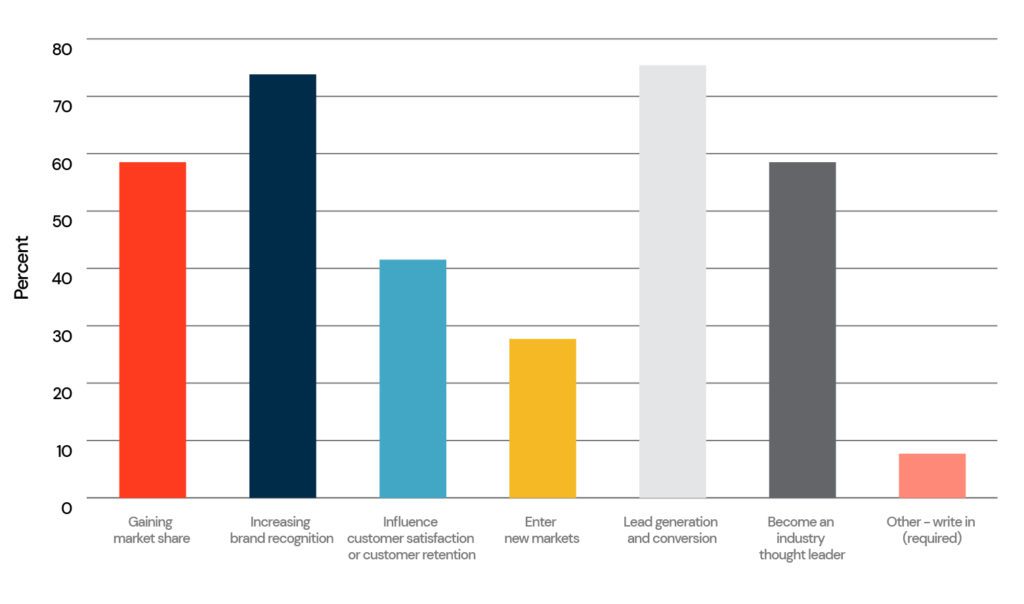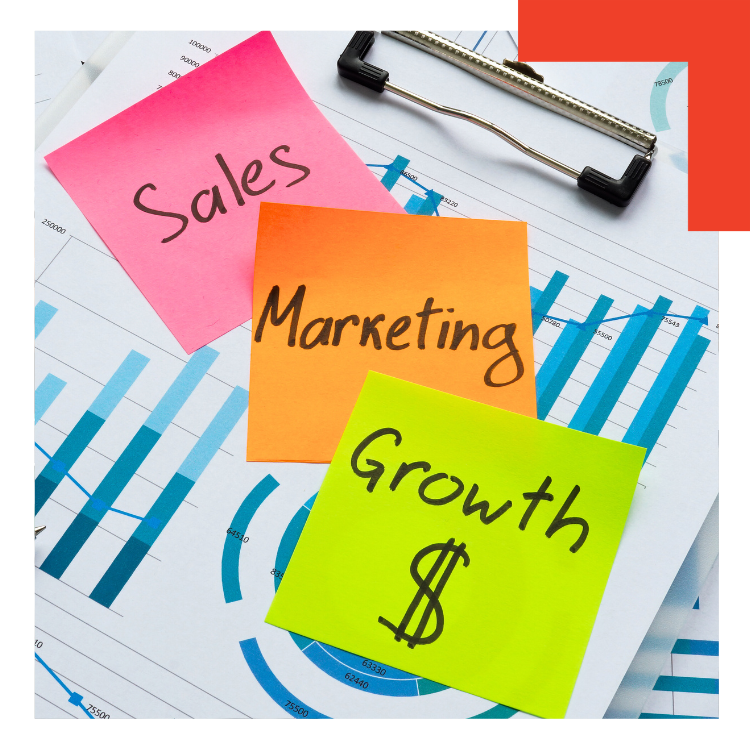
Supply Chain Marketers' Top 3 Objectives in 2023
If you're working to increase conversions, brand recognition, or break into thought leadership, read on for strategies to get you started.
Based on the 2023 Supply Chain Marketing Survey, most supply chain and transportation marketers’ focus has turned towards generating more leads and increasing conversions, increasing brand recognition,and becoming an industry thought leader:
What are your top objectives for 2022-2023?

In this blog, we’ll share insights and actionable tips to help you achieve your top objectives.
#1. Lead Generation and Conversion for Supply Chain Marketers
Generating leads is an essential part of any successful marketing campaign, so it’s important to have a strategy to help you bring in more leads. Before you start, it’s essential to align with your sales team to agree upon and define your target audience. Knowing exactly who you are targeting and their goals and needs will help you step into their shoes to create messaging and deploy them on the proper channels.
Here are a few of our top tips for generating leads and encouraging them to move through the funnel:
- Understand Your MQL Criteria: Your alignment with sales should continue beyond identifying your target audience. You should also align on what makes a good lead and what information you need to collect to discern whether it meets your criteria – a stage often labeled a Marketing Qualified Lead or MQL. You may use the BANT method (Budget, Authority, Needs, and Timeline) or a more sophisticated approach using demographic, firmographic, and behavioral qualifications. Identifying these criteria upfront will ensure you don’t waste resources trying to convert non-qualified leads and focus on those more likely to convert.
- Offer Quality Content & Resources Segmented by Lead Stage: Align top-of-the-funnel content to the prospect’s key business challenges and needs, middle-of-the-funnel content to their key drivers for evaluation and purchase, and bottom-of-the-funnel content to your competitive advantage (as it relates to your prospect, of course).
- Focus On Building Relationships: Take the time to learn about your prospects and their goals or interests. This helps you tailor your sales message and can also contribute to creating your ICP.
- Utilize Automation: Marketing automation tools can streamline connecting with prospects quickly and efficiently while allowing personalized messages explicitly tailored towards each target audience category over time, leading to increased conversions and cross-selling opportunities.
- Create A Follow-up Process For Qualified Leads Who Aren’t Ready to Buy: Not every lead will be in the market for your product or service right now. They can still become valuable customers in the future. Take the time to define a plan for nurturing these leads to continue to score them and gauge their interest over time.
#2. Increasing Brand Recognition for B2B Businesses
Brand recognition is essential for success in any B2B business, as it helps build trust among potential customers and increases the likelihood that they’ll choose to do business with you.
If 2023 is the year of brand awareness for your marketing strategy, here is some food for thought:
- Create Great Content: Publishing informative blogs, impact pieces, and guides help establish yourself as a credible source of knowledge and attracts potential customers.
- Utilize Social Media: A cost-effective way to build your brand’s recognition is by posting and actively engaging on social media platforms. LinkedIn is an obvious choice for supply chain marketers.
- Participate in Events: Attending supply chain events or hosting events showcasing new products or services are great ways to network and gain exposure for your brand. It also creates an opportunity for face-to-face interaction with potential customers. (We keep supply chain industry events up-to-date here for your convenience)
- Consider Co-marketing: Co-marketing can be an incredibly effective tool for increasing brand awareness. Not only does it allow you to tap into another company’s established customer base and network, but it can also help showcase your business. Aligning with another brand has the potential to double or even triple your reach and can be a win-win for both parties.
- Leverage Influencers: Engaging influencers in your target industry can be a great way to get more attention for your brand and reach out to potential customers. Partnering with influencers can also increase word-of-mouth marketing about your company through their established reputation, exposing your company’s name and services to their followers.
#3. Become a Supply Chain Industry Thought Leader
Becoming an industry thought leader can be incredibly rewarding, as it allows you to influence and shape conversations in your chosen field. Semrush says being a thought leader shows the audience that the company has strong opinions, experience, knowledge, transparency, a desire to share with others, and the ability to think outside the box.
If thought leadership is a top objective of yours, here are some tips:
- Identify Your Company Spokespeople: who can speak with authority on behalf of your company? Who has a unique perspective? Identify those individuals and pursue speaker training as necessary to prepare them for a thought leadership role.
- Get Out There Consistently: Once your thought leaders are adequately prepared, start sharing insights and opinions through multiple channels such as blogs, podcasts, webinars, sponsored and non-sponsored speaking engagements, and more. They may consider allowing their marketing department to post on their behalf to ensure consistency. Consistent content creation will enable people to get to know your spokesperson and helps establish credibility amongst potential customers or employers.
- Leverage Connections: Don’t underestimate the power of networking—engaging with like-minded people in the close-knit supply chain community can help open up opportunities for collaboration and growth. Connecting with influencers can also be critical to this objective to increase word-of-mouth marketing and expand your reach.
- Stay Ahead of Trends: Nothing will guarantee your success as a thought leader quite as much as a unique perspective and credible insight into future trends. Many seasoned executives are already closely watching market and industry conditions and sharing their personal takes internally – now it’s time to take that to a broader audience.
The next step for supply chain and transportation marketers is to evaluate their teams and budget to ensure they have the right pieces in place to launch new marketing tactics successfully. Our survey found that several companies in the industry need more team members or dedicated revenue to use marketing tools to their full advantage.
Interested in the full report? Enter your email address to receive a copy.
Interested in the full report?
Enter your email address to receive a copy.



